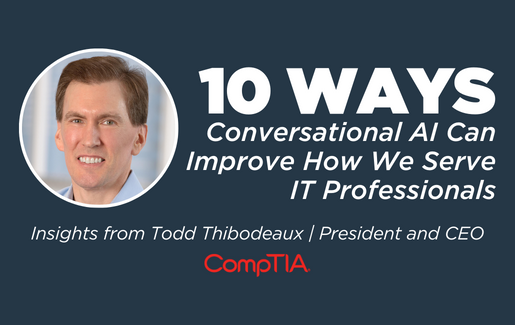 I’ve been watching, along with many of you, I suspect, as discussions about artificial intelligence (AI) have exploded into the mainstream after the release of ChatGPT. We’ve all interacted with customer service bots on the various sites we visit. And now, companies are starting to employ higher-functioning versions, including newly available application interfaces (APIs) designed by OpenAI, the creators of ChatGPT.
I’ve been watching, along with many of you, I suspect, as discussions about artificial intelligence (AI) have exploded into the mainstream after the release of ChatGPT. We’ve all interacted with customer service bots on the various sites we visit. And now, companies are starting to employ higher-functioning versions, including newly available application interfaces (APIs) designed by OpenAI, the creators of ChatGPT.
The AI space hasn't been immune to the Frogger-like progression we’ve seen for other innovations over the years. Some products and ideas get all the way to the other side of the river without much drama (PCs, Wi-Fi, HDTV, smartphones, printers, CD players, Bluetooth, app stores). Others get hit by a log a few times before finally happily hopping away (digital content, cloud anything, cordless phones, smart speakers, GPS, wearables, electric cars). And still more get creamed again and again, never quite getting to safety (AI, virtual reality, portable gaming, med tech, crypto so far). Not everything gains mass adoption, no matter how much we talk about it or wish it to be (the Metaverse).
Predicting the Success of Innovative Technologies
The number of product and service categories eventually surpassing 50% household or business penetration is shockingly small. An idea could be ahead of its time (Laserdisc, the Segway). It might be beaten by a less proprietary but inferior technology (Betamax vs. VHS). The predicted profit models never materialize, but the product survives (Uber/Lyft, Airbnb, Alexa as Amazon is discovering). But the best thing about the global tech ecosystem, and in the United States in particular, is it never gives up!
When evaluating innovation, I’ve always felt the best thing to do is air out ideas and beat them up. Think about what it would take for something to be truly successful and ignore the hype.
To me, any idea falls into one of three buckets:
- Redundant
- Complementary
- A true innovation
Products can be more than one thing at the same time. Combining their score across all three vectors helps define the chance of success.
The CD player is the classic example of this. At launch, it had high redundancy to LPs, cassettes and even radio. At the same time, it was very complementary with existing stereo components. Finally, there’s no denying it was a true innovation supported by broadly accepted technical standards. The redundancy was more than offset by its complementary fit. Then, when you add on an off-the-charts innovation score, it’s no wonder the CD player is, without question, one of the most successful tech products of all time.
Breaking Through the Hype to Achieve Real Results
Truly groundbreaking ideas, setting entirely new paradigms for what’s possible, don’t happen very often, so companies shouldn’t kick themselves too hard when they fail. Most businesses market products that are highly redundant and somewhat complementary but have very little true innovation. They shouldn’t be surprised when they're not rewarded with outsized returns. They can still be profitable, just not relatively more successful than other offerings. In this kind of world, the winning companies are the ones who do everything else (like customer success) really, really well.
Let's assume the hype is for real this time, and we should be paying rapt attention to the implications of ChatGPT and its ilk. How might this current iteration of AI help CompTIA build better products, more efficiently, for IT professionals over the next few years?
Here are 10 ideas for what conversational AI chatbots could do:
- Develop psychometrically equivalent exams on the fly, where no two forms are the same. It would be impossible to cheat since every question delivered was created in real time.
- Act as a virtual professor and provide students with context and answer their questions, based on CompTIA learning materials.
- Create a more interactive, user-friendly chat interface for data analytics based on sales information, student performance and more.
- Streamline the process for translating study materials and exams.
- Make products more accessible to people with disabilities.
- Help us create content-specific quizzes.
- Assist in efficiency scoring – comparing the performance of an individual against best practices and industry standards.
- Create an endless supply of practical exercises, with tickets for students to resolve and guidance for when they get stuck.
- Create an automated continuing education model tailored to a specific set of characteristics.
- Write first drafts of new content.
I’m very excited for the possibilities this technology can bring to CompTIA and to the tech industry. I hope the momentum is real this time. Like fusion power, AI has always been five years away for at least the last 20 years. In either case, we have to prepare ourselves and imagine the future.
CompTIA is here to support you throughout your IT career. Get free resources, career advice, and special offers on CompTIA training and certifications!
Todd Thibodeaux is the CEO of CompTIA.

